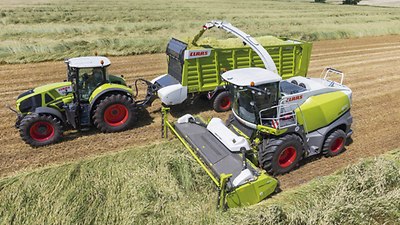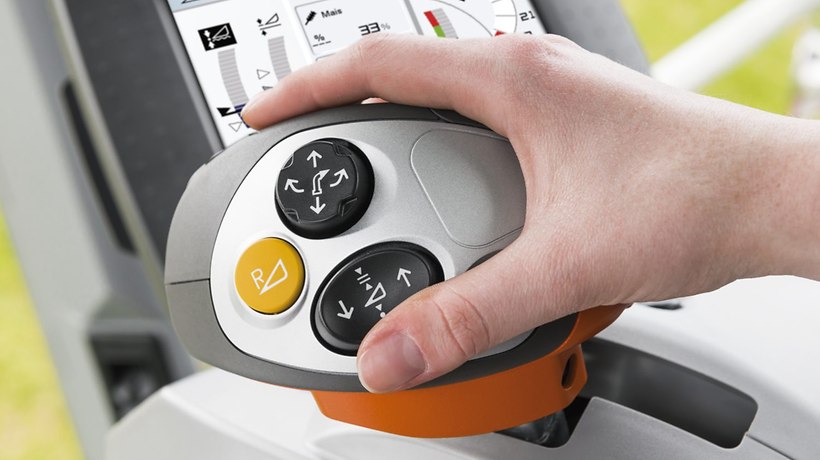With implementation of the Stage IV emissions standard across the range, CLAAS has introduced advanced technologies, new cracker rollers and implements as well as an exclusive tyre pressure control system for the steering and driven axles of the JAGUAR.
With new 6-cylinder inline engines from Mercedes-Benz and SCR technology for emissions treatment, all CLAAS JAGUAR models now fulfil the Stage IV (Tier 4) emissions standard. The AdBlue urea solution required by the system is carried on board in a 130 l tank. The two most powerful models, the 980 and 970, are however not covered by any emissions regulations due to their high engine power of over 560 kW. They have therefore retained their V8 and V12 engines from MAN.
Further development of DYNAMIC POWER
The engine is not the only factor which affects the efficiency of the machine, as intelligent management of the operating rate is also important. For this reason, CLAAS uses the DYNAMIC POWER automatic engine power control system in the JAGUAR and has developed it further for introduction to the 980 to 940 models, in addition to the 870 and 860, adding three modes which can be selected in CEBIS. DYNAMIC POWER controls the engine power depending on the engine speed. In the wide-open throttle range, the system achieves its maximum efficiency and throughput because the engine develops its maximum power at 1800 rpm. In the partial-load range with engine speeds of 1800 – 2000 rpm, the DYNAMIC POWER system adjusts the engine power to the operating conditions and gradually reduces the engine speed in 10 steps. This achieves a fuel saving of up to 10.6% in the partial-load range. Another new feature is that the driver can choose from the three engine power settings of three steps. The driver can choose “maximum power”, “high power” or “normal power”. A further new function is that during harvesting, the machine always drives into the crop at maximum engine power (stage 10) and only then does the system adjust the engine to the most efficient setting. This improves functional reliability.
CRUISE PILOT - Automatic speed control
The CRUISE PILOT automatic speed control system also helps to achieve the maximum engine operating rate and efficiency, while at the same time reducing the stress on the driver. In 2013, CLAAS introduced the familiar CRUISE PILOT system to its forage harvesters. Previously it had only been offered on the LEXION combine harvester. It was initially introduced to the top-of-the-range model, the JAGUAR 980. CLAAS is now making this technology available on a further six models, the JAGUAR 970 to 940 as well as the 870 and 860 models. To use the CRUISE PILOT, the driver first programs the desired target engine speed in CEBIS. It is activated easily using a push button directly on the multifunction lever. From this point, the JAGUAR continuously strives to drive at the specified engine operating rate. If the crop density suddenly increases, the vehicle speed is automatically reduced. If the crop density then reduces, the JAGUAR increases the vehicle speed until the specified engine operating rate is reached again. The control system operates by detecting the throughput volume and engine operating rate. The driver can choose between the three operating strategies of cruise control (constant vehicle speed), output (constant throughput) and maximum engine operating rate.
Tyre pressure control system for drive and steering axles
The JAGUAR has long been equipped with a tyre pressure control system on the front axle – with the familiar benefits of this technology: soil protection, improved traction and especially ride comfort in the field, high driving stability and minimised tyre wear on the road, as well as overall fuel savings. The JAGUAR 900 now becomes the first forage harvester on the market to be equipped with a dual-line tyre pressure control system for the drive and steering axles. The system allows significantly faster air exchange thanks to its two lines, a large air inflation/deflation line and a control line. The control line operates the rim valves and checks the set air pressure every 30 minutes. This ensures that the air pressure specified by the tyre manufacturer is maintained on the field and, in particular, on the road. Before using the machine, the driver sets the corresponding tyre inflation pressures – once for the drive axle tyres and separately for the steering axle tyres. During machine usage, the preprogrammed air pressures are always automatically adjusted depending on the position of the road travel switch, with the system automatically setting higher pressures for the on-road setting and lower pressures for the field setting.
MULTI CROP CRACKER – Two new cracker rollers for long-cut maize silage
On the JAGUAR, the chopped crop is conditioned by the MULTI CROP CRACKER (MCC), a flexible cracker concept which allows various cracker rollers with different roller profiles to be used depending on the crop type and desired conditioning level. The rollers can easily be swapped in and out as necessary. Until now, the CLAAS range of cracker rollers for maize silage has included the MCC CLASSIC (with medium or large roller diameter) with sawtooth profile for short-cut silage with chop lengths of 4.0-12 mm. CLAAS is now expanding its range with two additional cracker roller profiles for long-cut silage and Shredlage in maize. The new MCC MAX rollers have been developed for conditioning maize silage with chop lengths of between 15 and 22 mm. They operate with a sawtooth profile on 30 annular elements. Also new to the range, the MCC SHREDLAGE® cracker roller features a counter-rotating spiral groove in addition to the sawtooth profile. This cracker is thus capable of intensively conditioning maize with an unusually long chop length of 26 to 30 millimetres.
CMOTION multifunction lever – Now also for the JAGUAR
In future, the JAGUAR will be operated using the familiar CMOTION multifunction lever. It has proven its worth in practice and is popular for its ergonomic design combined with intuitive and sensitive operation. It can be used to control up to 13 machine functions. After introducing it for the first time to the XERION in 2009, CLAAS has continuously developed the multifunction lever and it is today installed on CLAAS tractors, the LEXION, the TUCANO and is now also optionally available for the JAGUAR. Hiding behind the complex technology is the simple aim of establishing one operating concept for all self-propelled CLAAS machines. Just get in and drive off.











